Photographer’s Paradise: Capturing the Beauty of Tianluokeng Tulou Cluster

An Essential Guide to Visiting Tianluokeng Tulou Cluster
Nestled amidst the lush, rolling hills of Fujian Province, the Tianluokeng Tulou Cluster is a remarkable testament to the ingenuity and resilience of the Hakka people. These magnificent earthen structures, dating back to the Qing Dynasty, are a sight to behold, showcasing an architectural style that has captivated travelers and historians alike. The unique arrangement of the buildings—four smaller circular Tulou surrounding a larger central one—symbolizes the strong familial ties that bind the Hakka community, reminiscent of a traditional family meal of “Four Dishes and One Soup.”
As you wander through this UNESCO World Heritage site, you’ll not only be stepping into a living museum of cultural heritage but also experiencing the breathtaking beauty of the surrounding landscape, with its mist-shrouded mountains and vibrant green terraces. Whether you’re an architecture aficionado, a history enthusiast, or a nature lover, the Tianluokeng Tulou Cluster offers a rich tapestry of experiences waiting to be explored. From savoring local delicacies to engaging with resident families who still inhabit these remarkable structures, every moment spent here promises to be an unforgettable journey into the heart of Hakka culture. Join us as we delve into the essential guide for visiting this extraordinary destination, ensuring you make the most of your adventure in this enchanting corner of China.
In This Guide
- An Essential Guide to Visiting Tianluokeng Tulou Cluster
- The Rich History and Legends of Tianluokeng Tulou Cluster
- Main Highlights: What You Absolutely Can’t Miss
- Planning Your Visit: A Practical Guide
- Tickets: Prices, Booking, and Tips
- How to Get There: A Complete Transportation Guide
- Local Cuisine and Accommodation Nearby
- Frequently Asked Questions
- Final Thoughts on Your Trip
The Rich History and Legends of Tianluokeng Tulou Cluster
Nestled in the enchanting hills of Fujian Province, the Tianluokeng Tulou Cluster is not just an architectural marvel but a living testament to the rich tapestry of Hakka culture and history. These unique earthen structures, known as Tulou, have stood the test of time and tell a story of resilience, community, and tradition.
The origins of the Tianluokeng Tulou Cluster date back to the late 18th century, during the Qing Dynasty. The first of the five notable buildings, the Buyun Tower, was erected in 1796. This square-shaped Tulou was designed not only as a residence but as a fortress, showcasing the Hakka people’s ingenuity in creating a safe haven against external threats, including bandit raids and natural disasters. The central location of Buyun symbolizes its importance as the heart of the Huang family settlement, where generations have gathered to celebrate their heritage.
The architectural design of the Tianluokeng Tulou Cluster is nothing short of spectacular. The cluster comprises five distinct buildings arranged in a formation reminiscent of “Four Dishes and One Soup,” where the larger central structure serves as a communal space, while the four surrounding buildings represent individual family units. This layout highlights the Hakka’s deep-rooted values of family unity and collaboration, which have been pivotal in maintaining their cultural identity through centuries of change.
Over the years, the construction of the remaining Tulou—Hechang, Zhenchang, Ruiyun, and Wenchang—occurred sequentially, culminating in the completion of the cluster in 1966. This architectural ensemble took nearly 170 years to complete, a reflection of the dedication and craftsmanship of the Hakka people. Each Tulou is three stories high, intricately designed to facilitate communal living while offering protection against the elements and intruders.
The Tianluokeng Tulou Cluster has also inspired legends and folklore. It is said that the unique formation of the buildings resembles a traditional meal, highlighting the importance of food and togetherness in Hakka culture. This symbolism is enhanced by the culinary tradition of “Four Dishes and One Soup,” which serves as a reminder of the shared meals that bond families together.
In addition to its architectural significance, the Tianluokeng Tulou Cluster is steeped in the everyday lives of its residents, who continue to live within these historic walls. Their stories, along with the age-old customs of the Hakka people, offer visitors a glimpse into a way of life that harmonizes with nature and emphasizes community.
Visitors to the Tianluokeng Tulou Cluster can marvel at its grandeur while also experiencing the vibrant local culture. As you wander through the pebbled paths and observe the intricate details of each building, you will feel a connection to the past and appreciate the enduring legacy of the Hakka people.
In essence, the Tianluokeng Tulou Cluster is more than just a collection of earthen buildings; it is a narrative of survival, community, and the unyielding spirit of a people who have thrived in the face of adversity. It stands as a crucial piece of cultural heritage in China, inviting travelers from around the globe to explore its rich history and legends.
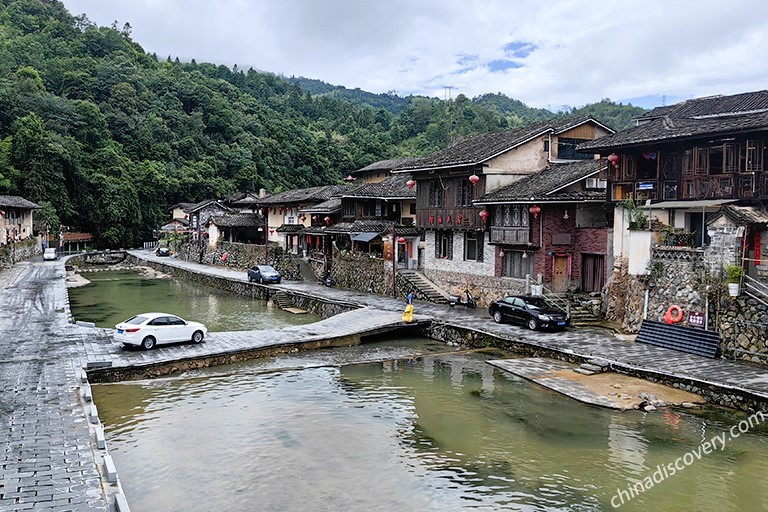
Tianluokeng Tulou Cluster.
Main Highlights: What You Absolutely Can’t Miss
The Tianluokeng Tulou Cluster is a remarkable testament to traditional Chinese architecture, nestled in the picturesque landscape of Fujian Province. This UNESCO World Heritage site is not only an architectural marvel but also a vibrant community that invites international travelers to explore its unique heritage. Here’s what you absolutely can’t miss during your visit:
The Iconic “Four Dishes and One Soup” Formation
As you approach the cluster, the first thing that will capture your attention is its distinctive layout. The Tianluokeng Tulou features five buildings arranged in a symbolic formation that resembles four dishes surrounding a bowl of soup. This configuration represents the traditional Hakka family structure, where the central Tulou serves as the communal gathering space, while the smaller ones represent individual family branches. This visual arrangement is best appreciated from the viewing platform above, where you can take in the full scope of this unique architectural design.
The Buyun Building
Start your exploration with the Buyun Building, the first Tulou constructed in the cluster back in 1796 during the Qing Dynasty. This square building stands at the heart of the complex and is steeped in history. Its name symbolizes blessings for prosperity and career advancement for future generations. The Buyun Building showcases traditional Hakka design, featuring three stories that house kitchens, barns, and living quarters. Be sure to admire the intricate details and craftsmanship that have persevered through the centuries.
Stunning Views from the Viewing Platform
Don’t miss the chance to ascend to the wooden platform at the east gate. This is the prime spot for panoramic views of the entire cluster and the surrounding landscape. Whether you visit during the day to bask in the natural beauty of the mountains or at night when the lanterns illuminate the buildings, the view is sure to be an unforgettable highlight of your trip.
The Vibrant Local Culture
Unlike some more commercialized tourist spots, Tianluokeng remains a thriving community. As you wander through the cluster, take time to interact with the local residents who still inhabit these structures. You can visit small shops selling local crafts and specialties, and perhaps even enjoy a meal featuring the famous Hakka cuisine, known for its hearty flavors and communal dining style.
The Rich Architectural Features
The Tulou are not just beautiful; they are ingeniously designed for defense and comfort. Built with thick rammed earth walls, these structures are resistant to fire, moisture, and earthquakes. The layout promotes ventilation and natural light, making them sustainable living spaces even today. As you explore, look for the unique architectural features that reflect the wisdom of the Hakka people in their adaptation to the environment.
Nearby Attractions
Extend your visit by exploring nearby attractions such as Yuchang Tower, the oldest circular Tulou, and the enchanting Taxia Village, ideal for hiking and experiencing unspoiled nature. Yunshuiyao Ancient Town is another gem, where stunning landscapes meet rich cultural heritage, perfect for those looking to capture breathtaking photographs or enjoy a leisurely stroll.
Practical Tips
- Entry Fee: The entrance to the Tianluokeng Tulou Cluster is 90 yuan, with a small transportation fee if you’re using public transport.
- Dress Comfortably: The paths are pebbled and can be slippery, so wear flat shoes or sneakers for a safe and enjoyable experience.
- Best Time to Visit: While the site is open year-round, visiting during the evening allows you to witness the magical ambiance created by illuminated lanterns.
A journey to the Tianluokeng Tulou Cluster offers a rare glimpse into the harmonious blend of nature, architecture, and culture that defines the Hakka way of life. Whether you’re an architecture enthusiast, a history buff, or simply a traveler seeking authentic experiences, this site promises to leave you inspired and enriched.
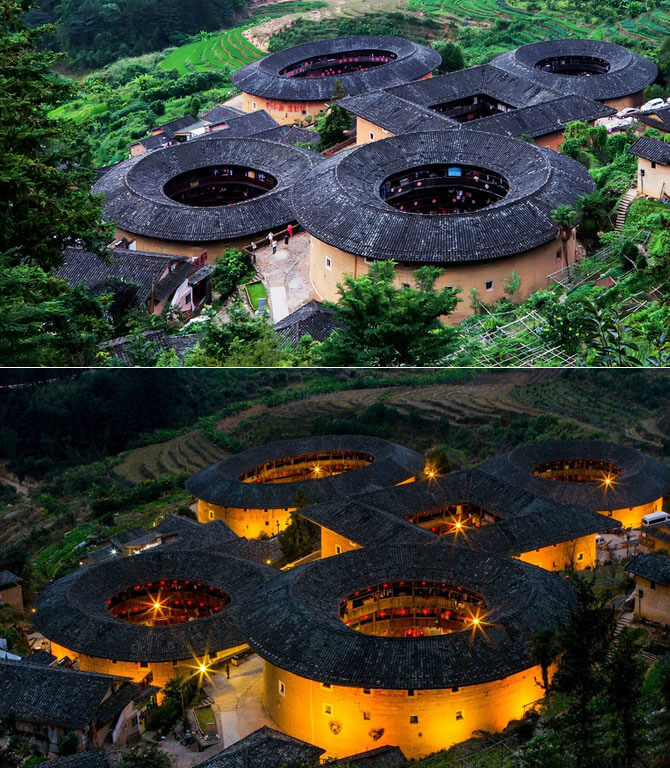
Tianluokeng Tulou Cluster.
Planning Your Visit: A Practical Guide
Visiting the Tianluokeng Tulou Cluster is a journey into a unique architectural and cultural heritage that offers an unforgettable experience. Nestled in the heart of Fujian Province, this cluster of earthen buildings, known as Tulou, presents a fascinating glimpse into the life of the Hakka people. Here’s everything you need to know to plan your visit effectively.
Getting There
Location:
The Tianluokeng Tulou Cluster is situated in Tianluokeng Village, Shuyang Town, Nanjing County, Fujian Province, China.
Transport Options:
– By Car: For a hassle-free experience, consider hiring a local driver or joining a guided tour. This option is particularly convenient, allowing you to explore the area without worrying about public transport schedules.
– By Bus: If you prefer public transport, take the Nanjing No. 6 bus to the Nanjing Tulou Reception Center. From there, a tourist bus will take you directly to the cluster.
– Parking: Ample parking is available near the viewing platform, except during peak times like Chinese New Year when spaces may be limited.
Entrance Fees and Operating Hours
- Ticket Price: Entrance to the Tianluokeng Tulou Cluster is priced at 90 yuan per person. There is an additional public transportation fee of 15 yuan per person.
- Opening Hours: The cluster is open year-round, 24 hours a day, allowing you to visit at your convenience.
What to Expect
The Tianluokeng Tulou Cluster is renowned for its distinctive “Four Dishes and One Soup” arrangement, which features five Tulou buildings. The central structure serves as a communal space while the four surrounding buildings represent different branches of the family. This layout not only showcases the architectural ingenuity of the Hakka people but also reflects their communal living traditions.
Best Practices for Your Visit
- Footwear: The paths within the cluster are paved with pebbles, which can be slippery. Wear flat shoes or sneakers for comfort and safety.
- Viewing Platform: For the best panoramic views of the Tulou cluster, start your visit at the wooden platform located at the entrance of the east gate. This spot offers a stunning vantage point to appreciate the unique layout of the buildings.
- Night Visits: If time allows, consider returning at night when the lanterns illuminate the Tulou, creating a magical atmosphere that enhances the beauty of this historic site.
Nearby Attractions
While at the Tianluokeng Tulou Cluster, consider exploring the following nearby sites:
- Yuchang Tower: The oldest and largest circular Tulou, dating back over 700 years, known for its remarkable engineering that has withstood several earthquakes.
- Taxia Village: A picturesque Hakka village ideal for hiking, surrounded by mountains and featuring quaint local eateries.
- Yunshuiyao Ancient Town: A beautiful heritage site that captures the essence of Fujian’s culture, often favored by filmmakers for its scenic backdrop.
Accommodation
While there are limited accommodation options directly within the Tianluokeng area, several guesthouses and hotels are available in nearby towns. Booking in advance is recommended, especially during peak travel seasons.
Duration of Stay
For a fulfilling experience, plan to spend at least half a day exploring the Tulou cluster and its surroundings. If you’re keen on hiking or delving deeper into the local culture, consider extending your stay to a full day or more.
Additional Tips
- Local Cuisine: Don’t miss the chance to taste authentic Hakka dishes served in local eateries, offering a delicious complement to your cultural exploration.
- Photography: Bring your camera! The Tulou cluster offers numerous picturesque opportunities, especially during sunrise and sunset.
- Respect Local Customs: As the area is still inhabited by local families, be respectful of their privacy and traditions while exploring.
With this practical guide, you’re well-equipped to embark on your adventure to the Tianluokeng Tulou Cluster. Enjoy the journey through history, culture, and breathtaking architecture!
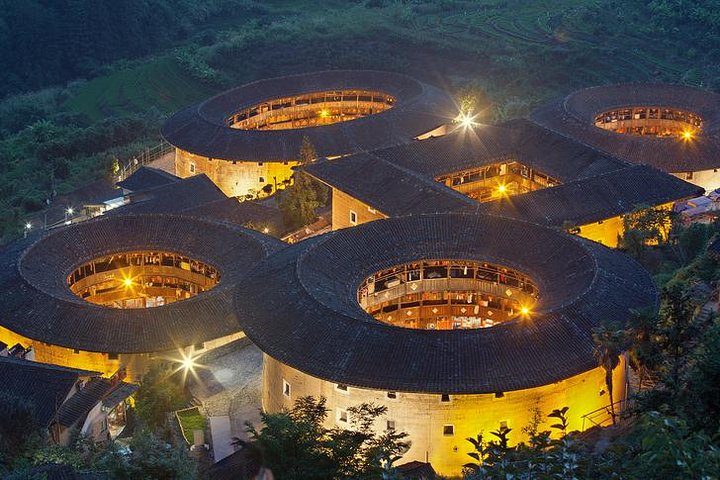
Tianluokeng Tulou Cluster.
Tickets: Prices, Booking, and Tips
Visiting the Tianluokeng Tulou Cluster is a fascinating journey into the rich cultural heritage of the Hakka people, and it’s essential to know the details about tickets, prices, and useful tips to enhance your experience.
Ticket Information
To explore the stunning architecture and unique landscapes of the Tianluokeng Tulou Cluster, you’ll need to purchase a ticket. The ticket price is 90 yuan per person. For those using public transportation to reach the site, expect an additional fare of 15 yuan per person for the bus ride.
Booking Your Tickets
Tickets can typically be purchased on-site upon arrival at the Tianluokeng Tulou Cluster. However, for a smoother experience, especially during peak tourist seasons, it’s advisable to check with local travel agencies or online platforms for advance bookings. Some guided tours may include the entrance fee, making it more convenient for travelers.
Opening Hours
The Tianluokeng Tulou Cluster is open 24 hours a day, allowing visitors to explore the area at their leisure. While daytime visits are popular, consider returning in the evening when the lanterns illuminate the Tulou, creating a magical atmosphere that highlights the intricate architecture.
Tips for a Great Visit
-
Footwear: The paths within the cluster are paved with pebbles, which can be slippery. Wearing flat shoes or sneakers is highly recommended for comfort and safety.
-
Best Viewing Spot: Don’t miss the wooden platform at the entrance of the east gate, which offers the best panoramic views of the Tulou. This is the perfect spot to take photos before you venture inside.
-
Timing Your Visit: If possible, plan your visit during the late afternoon or early evening. The sunset view from the hills surrounding the cluster is breathtaking, and the night view is equally stunning with the illuminated structures.
-
Transportation Options: While public buses are available, hiring a local driver or joining a tour can save you time and provide a more personalized experience. Parking is generally available near the viewing platform, except during the busy Chinese New Year period.
By keeping these ticketing details and tips in mind, your visit to the Tianluokeng Tulou Cluster will surely be a memorable part of your journey through Fujian Province!
How to Get There: A Complete Transportation Guide
To reach the stunning Tianluokeng Tulou Cluster nestled in the picturesque mountains of Fujian Province, international travelers have several transportation options. This guide will help you navigate your journey seamlessly, ensuring you arrive ready to explore this extraordinary UNESCO World Heritage site.
Arriving by Air
Fly into Xiamen or Fuzhou
The nearest major airports are in Xiamen (Xiamen Gaoqi International Airport) and Fuzhou (Changle International Airport). Both airports offer domestic and international flights, making them convenient starting points for your trip to the Tianluokeng Tulou Cluster.
From Xiamen
- By Train or Bus:
- Train: From Xiamen North Railway Station, take a high-speed train to Nanjing County. The journey takes approximately 2 hours, and tickets can be purchased online or at the station.
-
Bus: Alternatively, you can take a direct bus from Xiamen to Nanjing County. Buses depart regularly from Xiamen’s main bus station, and the journey typically lasts around 3 hours.
-
Local Transport to Tianluokeng:
- Once in Nanjing County, you can take the Nanjing No. 6 bus to the Nanjing Tulou Reception Center. From there, a tourist bus will take you directly to the Tianluokeng Tulou Cluster.
- If you prefer a more personalized experience, consider hiring a local driver or joining a guided tour that includes transportation.
From Fuzhou
- By Train or Bus:
- Train: High-speed trains run frequently from Fuzhou to Nanjing County and take about 2.5 hours. Again, tickets can be purchased at the station or online.
-
Bus: There are also long-distance buses from Fuzhou to Nanjing County, usually taking around 4 hours. Check the bus schedules for timings.
-
Local Transport to Tianluokeng:
- Similar to the journey from Xiamen, once you arrive in Nanjing County, hop on the Nanjing No. 6 bus to the reception center, followed by a tourist bus to the cluster.
Road Trip Options
For those who prefer a self-driving adventure, renting a car provides flexibility and the chance to enjoy the scenic beauty of Fujian Province. The roads are well-maintained, and GPS services can guide you to Tianluokeng. Just be mindful of parking availability, especially during peak tourist seasons. Parking is generally available near the viewing platforms.
What to Keep in Mind
- Ticketing: Entrance to the Tianluokeng Tulou Cluster is priced at 90 yuan, with an additional public transportation fare of 15 yuan per person.
- Dress Appropriately: The paths within the Tulou area are paved with pebbles, making flat shoes or sneakers the best choice to avoid slipping.
- Best Viewing Points: Before exploring the Tulou, visit the wooden platform near the east gate for panoramic views—especially stunning at night when lanterns illuminate the area.
By planning your transportation wisely, you can maximize your time enjoying the architectural marvels and rich cultural heritage of the Tianluokeng Tulou Cluster. Happy travels!
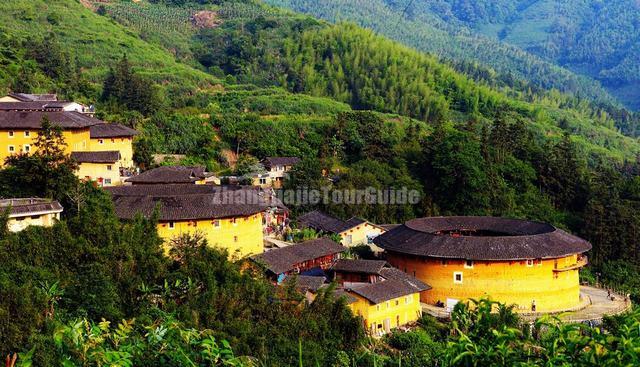
Tianluokeng Tulou Cluster.
Local Cuisine and Accommodation Nearby
When visiting the enchanting Tianluokeng Tulou Cluster, you’ll find yourself immersed not only in stunning architecture but also in the rich culinary traditions of the Hakka culture. The region is particularly known for its signature dish, affectionately dubbed the “Four Dishes and One Soup.” This hearty meal typically features a delightful mix of local vegetables, meats, and a comforting soup that embodies the essence of home-cooked Hakka cuisine. Be sure to try the following local specialties during your visit:
Local Delicacies to Savor
-
Hakka-style Pork: Slow-cooked and often marinated with soy sauce, this dish is tender and flavorful, embodying the rustic charm of Hakka cooking.
-
Stir-fried Vegetables: Fresh, locally sourced vegetables are stir-fried to perfection, sometimes with garlic or chili for added zest.
-
Rice Noodles: A staple in the region, these noodles can be found in various forms, often served in a savory broth or stir-fried with vegetables and meat.
-
Peanut Soup: A traditional Hakka dessert, this sweet treat is made with ground peanuts and sugar, creating a comforting finish to your meal.
For an authentic culinary experience, you can visit one of the small family-run restaurants near the Tulou cluster, where locals are eager to share their traditional recipes and stories.
Where to Stay
Accommodations near Tianluokeng Tulou Cluster range from cozy guesthouses to charming homestays, offering a glimpse into local life amidst the stunning natural surroundings. Here are a few recommendations:
-
Tianluokeng Tulou Hotel: Located within walking distance of the Tulou cluster, this hotel provides comfortable rooms with beautiful views of the surrounding landscape. It’s an excellent base for exploring the area.
-
Hakka Guesthouse: A delightful homestay option where you can enjoy Hakka hospitality. The host often serves home-cooked meals and can provide insights into the local culture.
-
Yuchang Tower Inn: Situated near the historical Yuchang Tower, this inn offers a unique stay in an authentic Tulou setting. Experience the architecture up close while enjoying modern comforts.
-
Taxia Village Homestays: For a more immersive experience, consider staying in one of the homestays in the nearby Taxia Village. Here, you can engage with local families and learn more about their everyday lives and traditions.
No matter where you choose to stay, the warmth of the Hakka people and their culinary delights will surely enhance your experience at the Tianluokeng Tulou Cluster. Enjoy your journey through this architectural wonder and the flavors that accompany it!
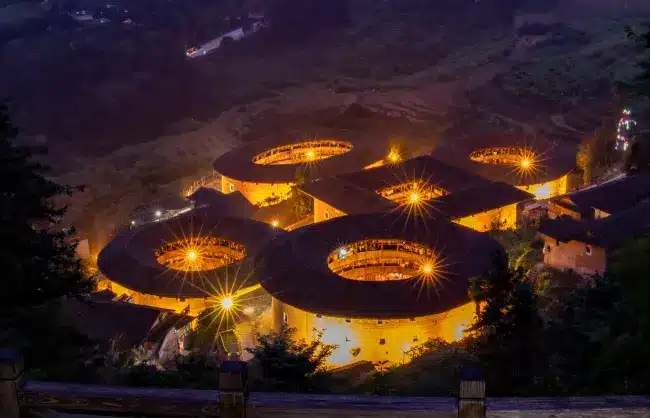
Tianluokeng Tulou Cluster.
Frequently Asked Questions
Frequently Asked Questions about Tianluokeng Tulou Cluster
1. What is the Tianluokeng Tulou Cluster?
The Tianluokeng Tulou Cluster is a group of traditional Hakka earthen buildings (Tulou) located in Fujian Province, China. It features a unique arrangement symbolizing family unity, consisting of five circular structures that resemble “four dishes and one soup.” These buildings serve as communal residences and are renowned for their historical and architectural significance.
2. How do I get to Tianluokeng Tulou Cluster?
To reach the Tianluokeng Tulou Cluster, you can hire a local driver for convenience or take public transport. From Nanjing County, the Nanjing No. 6 bus will take you to the Nanjing Tulou Reception Center, where you can catch a tourist bus directly to the cluster.
3. What are the opening hours and ticket prices?
The Tianluokeng Tulou Cluster is open year-round, 24 hours a day. Entrance tickets cost 90 yuan per person, and if you’re using public transportation, there’s an additional fare of 15 yuan per person.
4. What should I wear when visiting?
Comfort is key when exploring the Tianluokeng Tulou Cluster. The paths are paved with pebbles, which can be slippery. It’s recommended to wear flat shoes or sneakers to ensure a safe and pleasant walking experience.
5. Are there any nearby attractions worth visiting?
Yes! Nearby attractions include the historic Yuchang Tower, the scenic Taxia Village, and the picturesque Yunshuiyao Ancient Town. Each offers its unique charm and insights into the local culture, making them great additions to your itinerary.
6. How long should I plan to stay at the Tianluokeng Tulou Cluster?
A visit to the Tianluokeng Tulou Cluster typically takes about 2-3 hours. This allows enough time to explore the buildings, take in the scenery, and enjoy the local shops and eateries. If you have a keen interest in photography or architecture, consider extending your visit.
7. Is it possible to visit the cluster at night?
Absolutely! Visiting at night can be a magical experience as the lanterns illuminate the Tulou, creating a stunning visual effect. It’s a perfect opportunity for photography and a different perspective of this beautiful site.
8. Can I find local food and shopping options nearby?
Yes, the Tianluokeng Tulou Cluster is still inhabited by residents who operate various shops and eateries. You can sample authentic Hakka cuisine and purchase local crafts, making your visit not only a cultural experience but also a culinary delight.
Final Thoughts on Your Trip
As you conclude your journey through the breathtaking Tianluokeng Tulou Cluster, take a moment to reflect on the remarkable blend of history, culture, and natural beauty that this UNESCO World Heritage site embodies. The towering earthen structures, with their unique “Four Dishes and One Soup” arrangement, stand as a testament to the ingenuity of the Hakka people, inviting you to explore their rich legacy and communal spirit.
Walking through the pebbled pathways, you not only observe architectural wonders but also experience a way of life that has thrived for centuries. The vibrant atmosphere, enhanced by the welcoming smiles of local residents and the aroma of delicious Hakka cuisine, creates an unforgettable tapestry of sights, sounds, and flavors.
Whether you marveled at the intricate designs, captured the stunning landscapes from the viewing platform, or savored a local dish under the lantern-lit night sky, the memories you’ve created here will linger long after you leave. We hope this journey has ignited your curiosity and inspired you to delve deeper into the heart of China’s diverse cultures. As you carry these experiences with you, may they inspire future adventures and a greater appreciation for the world’s unique heritage. Safe travels!